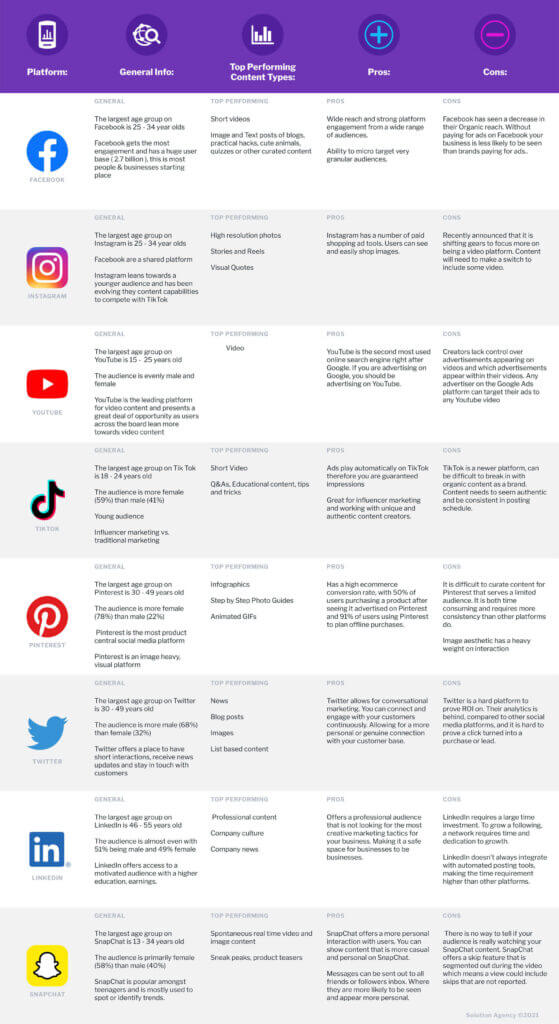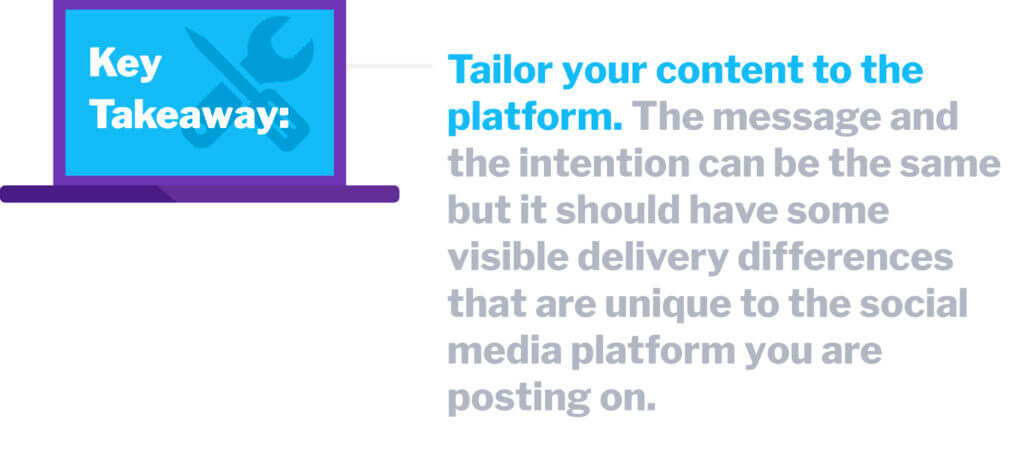
4 Easy Tips to Help Your Business Succeed on Social Media (and Avoid Frustration)
September 23, 2021 - Shannon

September 23, 2021 - Shannon
Getting started with social media for your brand or business often has the misinformed reputation of being a low maintenance and a low strategy task. In reality, that is not the case. If you are going to utilize social media for your brand, giving it the same access to time, resources, and qualified personnel as any other business asset is key for success.
Everything and everyone is online, it is crucial for a business to consider social media management as a core part of your business strategy for a number of reasons. Having fully fleshed out social media profiles can act as a trust signal for your brand – this is what we call “social proof” – showing people that your brand is legitimate on a platform other than your own website. Social media can also be a key way to engage with your customers, a place to source reviews, answer questions, take polls, and more.
Having active and relevant social media profiles can also help your business on the SEO (Search Engine Optimization) side of things – it’s basically impossible to get all of your website traffic from organic search alone, having other sources, like social media profiles, that support driving website traffic is important. Google takes into account your social presence (factors like follower counts, post shares, likes, etc) when determining SERP (Search Engine Results Page) rankings – a good social media presence can help your brand rank higher in the search results and get more traffic.
We see many clients get frustrated with social media – it can seem simple enough in concept to spin up a few profiles and make a few posts. However, what we most often see is brands spin up their profiles and make a few posts…and then inevitably let the profile go dormant when it doesn’t immediately take off with a huge following, or interaction rates. This common lifecycle of social media frustration does not need to be your business’s trajectory.
Here are four simple tips to help your brand be successful on social media platforms…
First, think about what goals your business is hoping to achieve by utilizing social media platforms. Your business goals are going to be unique to your business, and having a clear understanding of what you are hoping to achieve is going to set the foundation for which social media platforms you choose to engage with, and how you choose to do so.
Once you have determined what your goals are, you need to determine what data metrics define success for those goals. For example, if your goal is to drive awareness to a new product you might create a post talking about that new product, and your measurement of success might be how many people interacted with that post (likes, shares, comments).
Some common goals and their KPIs might include:
This is not an all-inclusive list of goals – need help determining the goals best for your business and setting up advanced goal tracking? Connect with our Digital Marketing team today to get started!

Key Takeaway: Understand the business goals you are trying to reach through social media before getting started.
Part of the idea behind having social media profiles is to get in front of and engage with your target audience in places where they are already hanging out online. It is very unlikely that your audience is active on every single social platform.
Different social media platforms warrant different types of engagement and are sought out for different types of information. You want to make sure that you are choosing the right social platforms that are relevant to your business, and are natural channels for you to communicate with your audience on. If you are trying to be on every single social platform – chances are you are wasting a lot of your time and energy screaming into the void because your audience isn’t actively engaged on that platform.
Although it can seem like it – your competitors aren’t on every social media platform either. That can give you one of two indications. One is that there is unclaimed territory. The other, that the platform is not worth it for the mutually shared audience you are after. You should research each platform carefully to determine which platform you can compete on if there are any platforms that are low-hanging fruit or platforms that will simply just not be worth your time.
Here is a breakdown of a couple of the major social platforms, what they are all about, what types of content perform best, and the pros and cons of each platform.


Key Takeaway: Your audience and your competition are not on every social media platform – you don’t need to be either.
You’ve taken the time to understand your goals, audience, competition, and which social media platforms might be right for you and have created your profiles on those platforms…so now what?
What you should avoid doing is creating a profile on a social platform and then ignoring it. Letting it go can be detrimental to brand reputation and trust – not to mention your business’s bottom line. A dormant profile can communicate a myriad of things very quickly to anyone who finds it. For instance, maybe this brand is no longer in business or they do not exist anymore. It sounds dramatic but a dead profile can be the end of the road to gaining a potential customer. It can also communicate the way your business engages with their customers – that you are unresponsive or have poor customer service.
Having social media profiles is a modern business requirement but when it isn’t maintained it has the potential to turn customers away. Successful brands on social media are posting consistent brand-relevant content and engaging with their audience.
It is key when building your social media strategy that you have adequate time and resources to give to it. Building an audience, building good content, and engaging on social media platforms doesn’t happen overnight – it is a consistent effort over time. Think about things like:

Key takeaway: If you do not have the resources & time to manage each social media profile effectively – don’t create that profile.
We are all users of social media in our daily lives – it’s easy to see that different social platforms house different types of content. For example, Youtube is used for posting videos, whereas Twitter is used for posting short text-based updates. Typically, content is not 100% interchangeable across platforms – you need to create content that is relevant for each platform.
A big mistake we often see is businesses that try to use one piece of content on every platform. Without making any significant change to the content or the way it is being presented. This is not using each platform to its full potential nor is it giving the content the chance to thrive in the right format to the right audience.

Key takeaway: Tailor your content to the platform. The message and the intention can be the same but it should have some visible delivery differences that are unique to the social media platform you are posting on.
Building out your social media strategy can seem daunting, but understanding a few simple principles can help your business see social success. Give your social media strategy the same access to time, resources, and personnel as any other business asset. Do the research and choose the right platform for your business so you stand a better chance at implementing a successful social media strategy. Good social media management requires time, resources, and a high-level strategy to become a valuable business asset.
Need help with your social strategy? Don’t have the time or resources your business needs to thrive on social media? Connect with a member of our strategy team to get started with social media management today.